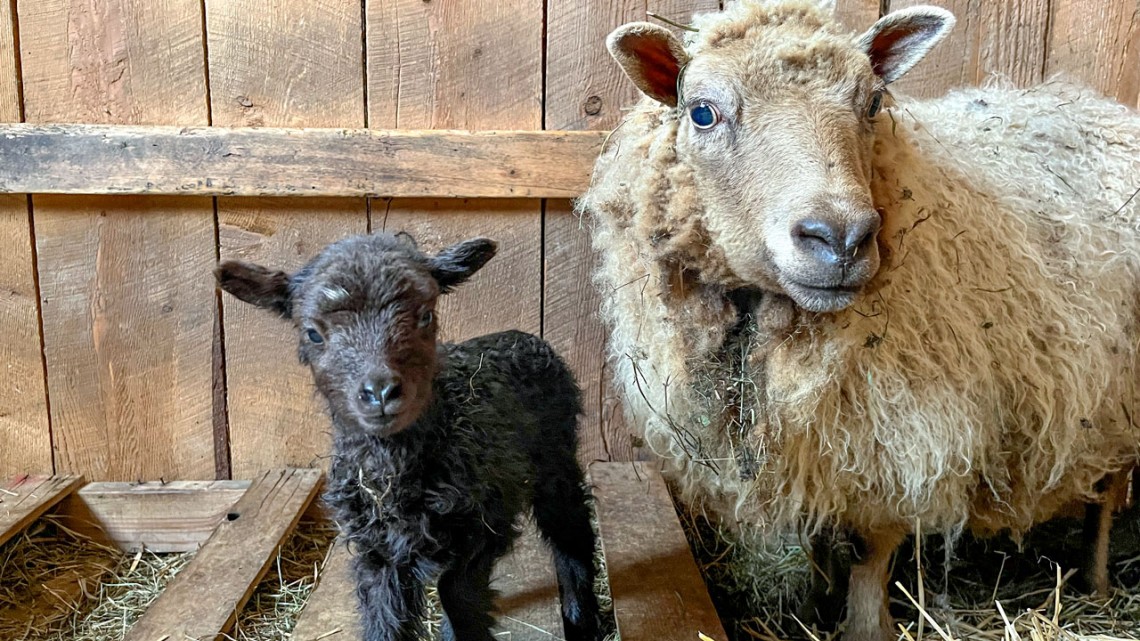
The Cornell University Hospital for Animals’ Ambulatory service came to the rescue when S'more the Shetland sheep, right, faced a life-threatening emergency after giving birth to twin lambs.
Cornell Veterinary farm call service saves mother sheep
By Lauren Cahoon Roberts
Rick Ryan is no stranger to helping his ewes during lambing season, but on a brisk evening in late March, he found himself out of his depth.
Ryan is a hobby farmer who lives in Dryden, New York, with his wife Theresa and two children, and works as a science communicator at the Cornell Laboratory for Accelerator-Based Sciences and Education. On this particular evening, Ryan’s favorite ewe was in trouble, and it was a condition that he’d never dealt with before.
“I was hit with an immediate feeling of being overwhelmed, and of uncertainty,” said Ryan, noting that the emergency would have turned fatal if it were not for the Cornell University Hospital for Animals (CUHA)’s Ambulatory service.
His oldest ewe, S’more, a Shetland sheep, had just birthed twin lambs, Graham and Mallow. The new family was recovering in the barn when Ryan’s 9-year-old daughter, Josephina, noticed that something was off. When Ryan went to check, he realized that what at first looked like the afterbirth was in fact something much more serious.
“It looked like a large mass, an organ,” he said. “It was something I just didn’t feel comfortable dealing with myself.”
The ewe was suffering from uterine prolapse, which happens when the mother continues pushing after lambing and pushes the uterus out the birth canal. It occurs in roughly one in 1,000 ewes during lambing.
The veterinarian on call at CUHA that night was service intern Dr. Mark O’Connor, who along with fourth-year veterinary student Heather Magnuson drove out to the Ryans’ farm. “Knowing Cornell veterinarians were on their way was immediately comforting,” Ryan said.
O’Connor and Magnuson arrived at the Ryans’ within the hour.
“We were glad to see that Rick had done a great job in keeping S’more safely separated from her flockmates to prevent injury to her exteriorised uterus,” O’Connor said. “It was also relieving that the uterus appeared relatively clean and healthy – thanks to Rick and his children being so quick to notice the problem.”
The case was textbook, O’Connor said, making their treatment straightforward. They first separated the placenta that was still attached to the uterus. Once the placenta was removed and the uterus cleaned off, Magnuson administered an epidural with local anaesthetic so that S’more would allow them to re-insert the uterus.
O’Connor had Magnuson reinsert the uterus, as she has smaller hands and wrists and could reach further inside the ewe. Ryan recalls the moment when Magnuson donned the large, yellow glove to perform the procedure.
“She was framed by the floodlights,” he said, “and my 7-year-old son, Theo, looked up at her and said, ‘You’re a superhero!’ and he was right. It really felt like we had these two superheroes helping us in our barn.”
After Magnuson had replaced the uterus, she and O’Connor used a funnel to pour warm water inside, to help the uterus expand and stay in place.
With the ewe’s situation stabilized, the superhero duo gave Ryan a syringe of antibiotics to administer 48 hours later. Ryan knew how to administer such medications thanks to previous visits by another ambulatory service clinician, Mary Smith ’69, D.V.M ’72, who just happens to be a world-renowned expert on sheep.
“Having the Cornell team brings this great sense of calm,” Ryan said. “They have everything under control, and I know that calling them is the absolute best thing we can do in these situations.”
A version of this story appears on the College of Veterinary Medicine website.
Lauren Cahoon Roberts is director of communications at the College of Veterinary Medicine.
Media Contact
Get Cornell news delivered right to your inbox.
Subscribe
